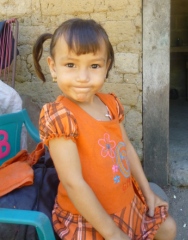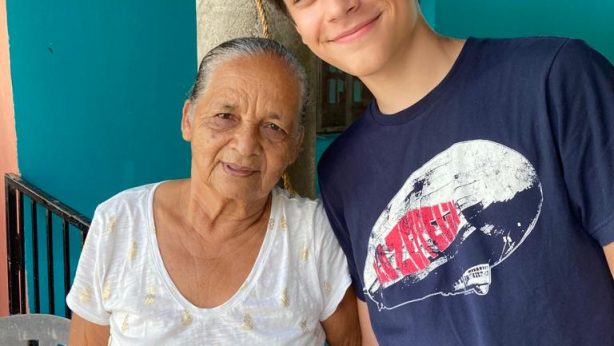Heavy Rains and Hurricanes’ Impacts in Honduras and New York
 Marta Rosa is a new client from Choluteca on her first loan cycle. She became a part of Adelante to increase production of enchiladas and tacos that she makes and sells alongside her 22 year old daughter. Although Marta has been doing this for many years, last October’s heavy rains left her and her family homeless. Her two sons have not been able to secure steady jobs, being forced to settle for seasonal agricultural employment.
Marta Rosa is a new client from Choluteca on her first loan cycle. She became a part of Adelante to increase production of enchiladas and tacos that she makes and sells alongside her 22 year old daughter. Although Marta has been doing this for many years, last October’s heavy rains left her and her family homeless. Her two sons have not been able to secure steady jobs, being forced to settle for seasonal agricultural employment.
The devastating rains of last year remind us of why Adelante began in the first place—in response to the devastation left by Hurricane Mitch. However, for me, a native New Yorker, her story makes me reflect on the damage just recently left behind by Hurricane Sandy and last year’s Hurricane Irene. I was thankful to see Hurricane Sandy pass by a few weeks ago without leaving any or minimal damage to my own family and friends. Last year, my family was not so lucky.
I was in Quito, Ecuador on orientation for a semester abroad last August when I first heard about a hurricane heading toward New York but the news I had read seemed to predict greater problems for New York City and other downstate areas than where my family lives outside of the capital of Albany. After getting to Guayaquil, where I would be studying during the fall semester of my senior year, I got a call from my parents. Although New York City had been spared much predicted damage, parts of Upstate New York and Vermont were not so lucky.
After losing power the day before, my family had been woken by police at their door around 1:00 am to evacuate their home in late August. They loaded what they could into their car but most of my belongings that I had left while I was abroad remained in the basement. In the rush of moving out of my apartment and packing for my semester abroad, I was left with little time to label or organize the boxes I was leaving behind. For the next two months, my parents stayed with family and received the support of members of the community who were not affected.
Down the street from my house on one side is a lake where I had learned to swim and on the other side, a river where I watched the Village of Scotia water ski shows and fireworks as a child. The rains that hit my town resulted in the overflow of the Gilboa Dam, flooding from the lake and river into my town and water eventually breaking through the foundation of my house. By the time I arrived back from Ecuador, the house was almost done with repairs and my parents had been able to resume their normal lives.
The devastation that my family and others were faced with was also often met with community support and generosity. When I spoke with Marta, many things raced through my mind. In her rural community, about an hour out from the closest city, were police officers able to be effectively assisting with evacuations?  Even if they could evacuate people from areas in danger, would they all have had somewhere to go? Unlike my parents, she certainly did not have flood insurance to cover at least some of the costs. Moreover, Marta’s neighbors do not have the same capacity to support each other during these disasters that my family’s community does.
Even if they could evacuate people from areas in danger, would they all have had somewhere to go? Unlike my parents, she certainly did not have flood insurance to cover at least some of the costs. Moreover, Marta’s neighbors do not have the same capacity to support each other during these disasters that my family’s community does.
After losing her home, she was able to move into a rental owned by a neighbor, where she lives with her three children all in their 20s and her three year old granddaughter. Her husband passed away 15 years ago so they must all work together to cover their household expenses, which now include the cost of renting and will soon include her granddaughter’s school expenses. Her two sons both work in agriculture, typically finding work during harvest season. During other times of the year, it is harder for them to find work, making Marta’s business even more vital to the well-being of her family.
Marta and her 22 year old daughter run their business together making and selling tacos and enchiladas in the community. They share responsibilities in making the food, and her daughter goes out to sell their food while she  cares for her granddaughter. After relocating and reestablishing their business after last year’s rains, they are starting to build up a new clientele. Marta is proud of the work she and daughter do, saying, “She goes out everyday to sell the food we make and now those who have tried it love it and go looking for her to buy more!”
cares for her granddaughter. After relocating and reestablishing their business after last year’s rains, they are starting to build up a new clientele. Marta is proud of the work she and daughter do, saying, “She goes out everyday to sell the food we make and now those who have tried it love it and go looking for her to buy more!”
Marta’s dream is to someday have a home that she can call her own again. In July she took out her first loan for $166. She hopes that with the new investment, she will be able to grow the business that she and her daughter have developed together and eventually be able to own her own home again.



